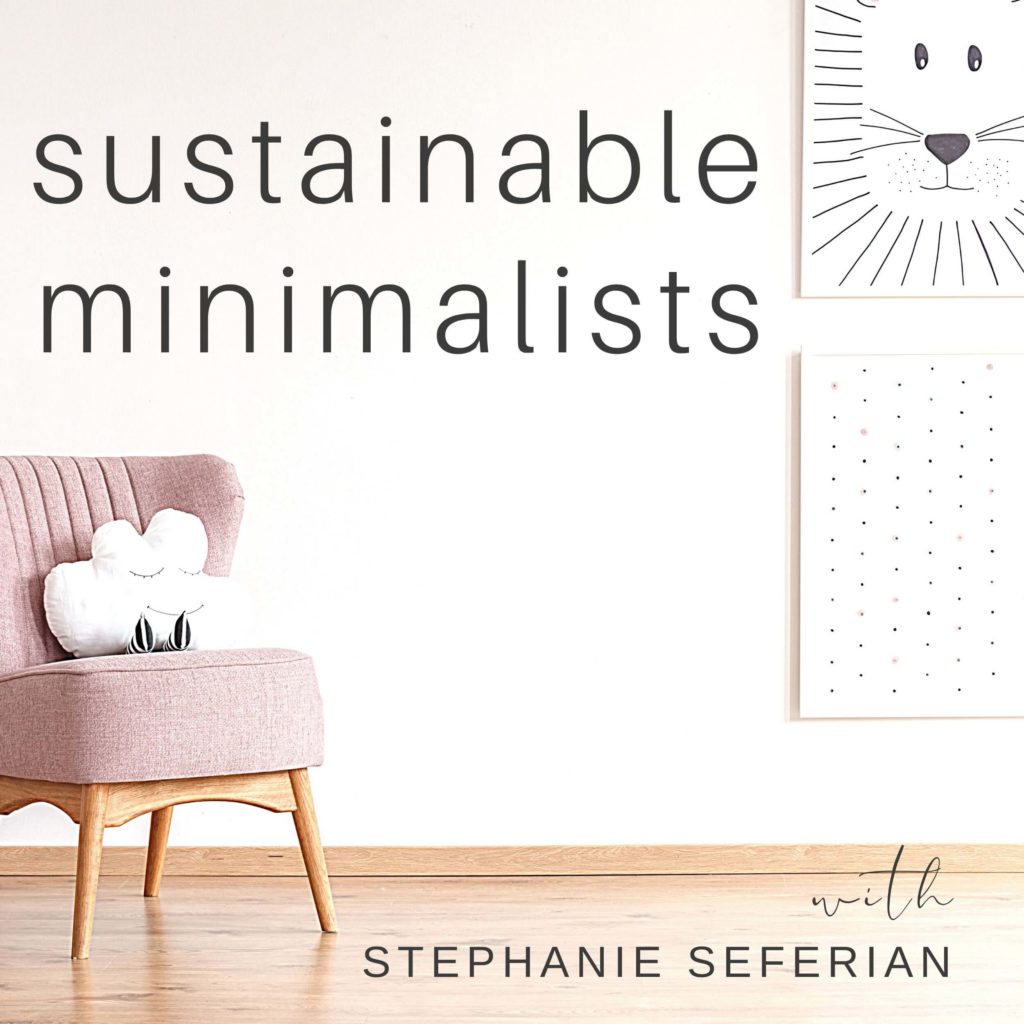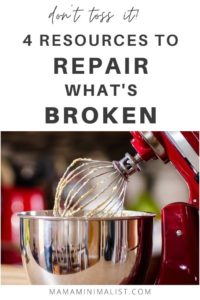What is Planned Obsolescence? (And How to Repair)
What is planned obsolescence? 4 ways to manage what’s broken
By Cheryl Leutjen
What is planned obsolescence, and what do we do with all the broken things in our lives? These days, items break all the time. The easiest solution for most of us is to trash what’s broken and buy new.
Repairs, when available, often cost more than purchasing a new item. Worse, few of us possess the knowledge to fix the ever more complex gadgets we use every day.
One of the more difficult challenges to sustainable minimalism is figuring out what to do with all the broken stuff that accumulates. As sustainability enthusiasts, we aim to fix or reuse all that we can, rather than send them off to the landfill. Figuring out how to make those repairs, however, can be challenging, especially if you’re not a skilled technician.
Let’s explore some of the available options for returning those goods back to useful service.
What is planned obsolescence?
Planned obsolescence is a hot button issue right now, and you may find yourself asking yourself, what, exactly, planned obsolescence looks like in daily life.
Planned obsolescence is the term used to describe the intentional breakage of store-bought products. It’s limited warrantees that expire just after an item breaks; it’s defunct power cords that are no longer compatible with updated electronics, too.
Here’s an in-depth look at planned obsolescence in practice.

Option 1: DIY Repairs
Many broken items require only a simple fix to return to usefulness, though we may need to learn some new skills to implement them.
WikiHow, Instructables.com and YouTube offer a myriad how-to videos for repairing everything from a leaky aquarium to a broken zipper.
But the sheer number, not to mention variable quality, of how-to videos on YouTube can be overwhelming. WikiHow may be a simpler option if the site addresses your broken item.
Here are some fix-it ideas for commonly-broken items, but note that many of these repairs may require purchasing supplies or tools. (Please note: I have only showcased fixes that utilize supplies which can be reused for multiple items. )
Eyeglasses. This WikiHow article offers step-by-steps instructions for repairing a broken bridge, replacing a lost screw, and removing scratches from eyeglasses and sunglasses.
Mini-blinds. Do your pets or toddlers ruin mini-blind slats? Learn to replace broken or bent mini-blind slats.
Torn clothing. Even if you aren’t a seamstress, the trend of “visible mending” makes torn clothing repairs within reach of anyone with a needle and thread…and some patience. Obvious patches and visible stitches have become a new artform. See this site for detailed instructions for beginners.
Flip flops. A beloved pair of flip flops is a joy…until the plastic strap breaks. The shoe repair shop can fix them, but the cost will be several times what you paid for the shoe. Learn to repair your own flip flops and you may love the result even more.
Plastics. So much of the household and personal items we use everyday are made of plastic that’s impossible to repair at home. That said, learning to use a soldering iron may allow you to repair some of those items. See this Instructables.com video to get started using a soldering iron to weld more rigid plastic items like storage containers, hangers and car parts, for practical reuse.
Option 2: Get Help
If a broken item is repairable but not by you, seek out free assistance.
Asking for help with a repair is the sustainable minimalist version of borrowing the proverbial cup of sugar, a custom that many of us urban dwellers who hardly know our neighbors have abandoned.
A more sustainable future means letting go of unjustifiable norms which imply that asking for help is intrusive or a sign of weakness.
Get help from someone local
Post your request for repair assistance on any social media app with a local focus, such as NextDoor or in the “Neighbor Posts” section of the Patch site for your area. You may be surprised to find how many local tinkerers are looking for ways to practice their skills.
If you have a local Buy Nothing group, you can ask for a “gift of time” in repairing the item. Buy Nothing members offer goods and services within their communities without exchange of money, and many tinkerers welcome the opportunity to apply their skills, especially within the confines of a giving community. You can find your local Buy Nothing group here.
You may also find a tinkerer to help at a local Repair Café. These events are staffed by local volunteers with skills in repairing everything from appliances to bicycles.
You may also find supplies for making your own repairs, if you lack the tools or materials. Or you may find an expert who will repair for you.
Bring your broken gadget and plan to arrive early as the growing popularity of these events mean that there may be a long line for your preferred tinkerer.
If you’d like a glimpse into the Repair Café philosophy and function, check out this video. See if there’s a repair café near you. If none is available, consider starting one!
Prefer Audio?
You can find The Sustainable Minimalists podcast (and much more!) wherever you listen to podcasts.
Apple Podcasts | Google Podcasts | Spotify | Stitcher
Get help from the manufacturer
Sustainability-minded companies like Patagonia, Arc’teryx and Chaco offer lifetime guarantees and/or repair services for their worn gear. The scope of the guarantee, cost of repairs, and terms of service vary by company.
See this list of manufacturers that offer a lifetime guarantee and/or repair services. Be sure to read all of the qualifications to ensure your item will be repaired (rather than trashed and replaced) for full sustainability impact.
Close the Loop.
Note that, if the manufacturer of your broken item isn’t on this list, consider patronizing one of these companies when you make your next purchase.
Vote for closing the linear, one-way manufacturing practice, and send your purchasing dollars to companies embracing the circular economy.
Right to Repair.
Consider also contributing to the Right to Repair movement.
As consumer products become more complex and companies demand protection of their intellectual property, many manufacturers require consumers to seek repairs through authorized vendors.
Bills before several state legislatures would demand companies to allow individuals the basic right to repair the goods they own. Get more information here and here.
Option 3: Upcycle
If your broken item can’t be repaired by you or anyone else, consider alternative uses for it.
Pinterest and crafting bloggers offer a myriad of ideas, such as making fancy drawer pulls from broken brooches and bookshelves from broken ladders.
If you’re looking for a more targeted assistance, ask for upcycling ideas for your specific broken thing from the Sustainable Minimalist group on Facebook or from any “Zero Waste” group on Facebook, Meetup.com or neighborhood apps like NextDoor.
Option 4: Recycle
Recycling should always be your last resort, as waste management companies do not recycle much of what we place into the bin.
When all else fails, check Earth911.com for insight on companies that will actually recycle consumer goods, from automotive fluids to CFL bulbs for beneficial use.
[RELATED: Your recycling is headed to the landfill. Here’s why.]
The final word: Let go of the guilt
Repairing or upcycling all the broken goods in our households can be time-consuming and energy-sapping.
Do what you can, and honor your own best intentions.
In the end, the manufacturers that put goods into the marketplace without any plan for recovery are to blame. Their lack of compassionate foresight isn’t worth carrying the guilt of a broken widget gone to the landfill.
Restore your well-being with meditation, time in nature or any other practice you find sustaining. Then embrace your renewed energy level to face the next sustainable minimalist challenge.
Cheryl Leutjen’s deep love of Earth as well as her hope for a bright future for her children fuel her passion for responding to the challenges of our time with heart, hope, humor, and spiritual practice.
Cheryl writes and speaks to share her experiences on the razor’s edge between Earth-mindfulness and eco-madness.
Learn more at cherylleutjen.com.
Stay in-the-know!
Sign up for monthly eco-minimalist inspiration.




